Efektifitas Pengisian Baterai Menggunakan Solar Panel 50 WP (Watt Peak) dengan Metode PWM (Pulse Width Modulation)
DOI:
https://doi.org/10.34151/jurtek.v16i1.4186Keywords:
Photovoltaik, Pulse Width Modulation (PWM), solar panelsAbstract
Electrical energy has become a basic need for humans today, almost all aspects of human life require electrical energy. The electrical energy needed so far has been produced from fossil energy which is not environmentally friendly and has dwindling reserves, alternative energy is needed which is environmentally friendly and sustainable. Energy that can be utilized includes water energy, wind energy, solar energy and so on. The sun is one of the abundant energy, by crossing the equator, Indonesia has enormous energy reserves. This potential is expected to become Indonesia's future energy. Currently solar cell technology is very advanced with increasingly good efficiency, in addition to energy conversion by solar cells with photovoltaic technology, a method is needed to store the results of the conversion into storage (batteries) optimally. One of the battery charging technologies is the Pulse Width Modulation (PWM) method, with this method battery charging is optimal on a 50 WP solar panel. In this study, a 50 WP solar panel was used, a 28 Ah 12 Volt battery, a 10 Watt Dc 12 Volt load and a 10 Ampere PWM Solar Charger Controller (SCC). The system was running for 3 months from September to December, the load was turned on for 12 hours every day with a load absorption current of 0.9 Amperes. Every day the current used is 10.8 Amperes. For 3 months the weather was not always stable, so charging was less than optimal, but until now the system is running well with an average after usage voltage of 12.3 Volts.
Downloads
References
Haryanto, T. (2021). Perancangan Energi Terbarukan Solar Panel Untuk Essential Load Dengan Sistem Switch. Jurnal Teknik Mesin Mercu Buana, 10(1), 41-50.
Irfan Mahrubi, Jusuf Bintoro, Wisnu Djatmiko. 2018. Rancang Bangun Solar Charge Controller Menggunakan Syncronous Non-Inverting Buck-Boost Converter pada Panel Surya 50 Watt-Peak (WP) Berbasis Arduino Uno V3.0. Jurnal Pendidikan Vokasional Teknik Elektronika Vol I No.1.
Johar, L. W. (2020). Desain Charger Control Pembangkit Listrik Tenaga Hybrid Dengan Pengaturan Duty Cycle PWM. Journal Of Electrical Power Control And Automation (Jepca), 3(2), 49-52.
Matalata, H., & Effendi, A. (2022). Unjuk Kerja Charge Controller metode PWM Menggunakan Arduino Uno. Jurnal Teknologi, 15(1), 1-8.
Mustiadi, I., & Utari, E. L. (2022, August). Perbandingan Efektivitas Pengisian Baterai Menggunakan Metode PWM dan MPPT pada Modul Solar Panel 50 WP. In Seminar Nasional Teknik Elektro, Informatika dan Sistem Informasi (Vol. 1, No. 1).
Muttaqin, I., Irhamni, G., & Agani, W. (2016). Analisa rancangan sel surya dengan kapasitas 50 watt untuk penerangan parkiran Uniska. Al Jazari: Jurnal Ilmiah Teknik Mesin, 1(1).
Rusman, R. (2017). Pengaruh Variasi Beban Terhadap Efisiensi Solar Cell Dengan Kapasitas 50 Wp. Turbo: Jurnal Program Studi Teknik Mesin, 4(2).
Saiful Karim, Dwi Cahyanto, 2019. Analisa Penggunaan Solar Cell Pada Rumah Tinggal Untuk Keperluan Penerangan dan Beban Kecil. Jurnal EEICT Vol 2 No 1.
Sardju, A. P., & Abbas, M. Y. H. (2021). Perancangan Charge Controller Untuk Pengisian Baterai Pada Sel Surya. Journal of Science and Engineering, 4(1), 47-52.
Tampubolon, A. P., Adiatma, C. J., Tumiwa, F., & Giwangkara, J. (2019). Laporan Status Energi Bersih Indonesia. IESR [Online].
Tanwir, T., & Muid, F. (2019). Penyerapan Energi Matahari Pada Solar Cell Dengan Menggunakan Sistem Tracking. Jurnal Teknik Mesin, 8(2), 13-25.
Downloads
Published
How to Cite
Issue
Section
License
Copyright (c) 2023 Ikhwan Mustiadi, Evrita Lusiana Utari

This work is licensed under a Creative Commons Attribution 4.0 International License.
Jurnal Teknologi provides immediate open access to its content in order of making research freely available to the public to support a global exchange of knowledge. All articles published in this journal are free for everyone to read and download, under licence CC BY SA.
Benefits of open access for the author, include:
- Free access for all users worldwide.
- Authors retain copyright to their work.
- Increased visibility and readership.
- No spatial constraints.




















